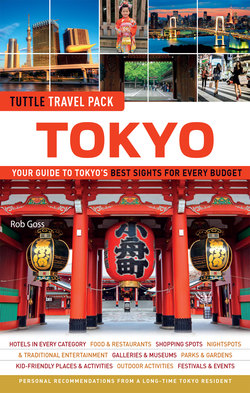Читать книгу Tokyo Tuttle Travel Pack - Rob Goss - Страница 7
На сайте Литреса книга снята с продажи.
ОглавлениеTokyo at a Glance
Geography
Situated in the center of the Kanto region, on the eastern side of Japan’s main island Honshu, Tokyo’s core is comprised of 23 ku (wards), with another 39 municipalities (shi) to the west of these. There are also two island chains that fall under Tokyo’s jurisdiction, the Izu Islands and the Ogawasara Islands, the latter lying 1,000 km (620 miles) south of Tokyo.
Climate
In winter, Tokyo tends to be quite dry and mild (and very often sunny), with the temperature rarely dropping below 0 °C and often in excess of 10 °C. Spring is heralded by a pink front of cherry blossom in late March and early April, signaling the arrival of pleasantly warm temperatures that will last through May (and the arrival of cedar pollen that has some 20% of Tokyoites watery eyed hiding behind surgical masks). Separating spring from summer is a three- to four-week rainy season in June, during which the heat and humidity start to rise and the skies remain mostly grey.
From July the rain gives way to clear summer skies—occasionally punctuated by a typhoon—that last through to late September. Summer high temperatures are typically around 32 °C–35 °C with midnight lows around the 25 °C mark, and the humidity can be extremely oppressive. After several months of sweating and natsu bate (summer fatigue), the temperatures begin to drop with the start of autumn in October. It’s a wonderful time to visit Japan as the skies stay clear, the air feels fresh again and for a couple of months the high temperature hovers in the low to mid-20 °C.
Modern Tokyo still has some traditional houses
People
At last count, Tokyo’s population was 13.2 million, representing just over 10% of the population of the entire country. Some 35 million people live in the Greater Tokyo area, which is comprised of Tokyo and the neighboring prefectures of Chiba, Kanagawa and Saitama. Although Tokyo’s population has been rising since the end of World War II, when it had fallen to 3.5 million, that growth isn’t expected to last. According to the most recent national census, Japan’s declining birth rate could see Tokyo’s population drop under 12 million by 2050 and under 8 million by 2100.
Language
The official language of Japan is Japanese (apologies for stating the painfully obvious) and is the first language of 99% of the Japanese population. Besides Japanese, Okinawa in the far south also has its own related but minor Ryukyuan languages, while the indigenous Ainu people of Hokkaido in the far north have the unrelated Ainu language. With three separate writing systems (the complicated kanji and the easier phonetic hiragana and katakana) which between them use thousands of different characters, not to mention a complex system of honorifics, Japanese isn’t the easiest language to quickly get to grips with. That said, in central Tokyo and the main tourist areas you will easily be able to get by in English. If you’d like to try speaking a bit of Japanese (and it will be appreciated), have a look at the section on useful expressions and pronunciation on pages 89–91.
Tokyo Tower, one of the city’s most distinctive landmarks, sharing the skyline with the towers of Roppongi (left).
Religion
The Japanese typically say they are born Shinto but die Buddhist, in reference to the traditional rituals used for birth and death. In fact, they don’t really consider themselves to be religious at all; more than 80% say they have no religious affiliation and 65% don’t believe in God or Buddha. Instead, you can think of Buddhism, which arrived from China in the 6th century, and Shinto, the indigenous religion of Japan, effectively forming one set of traditional practices that are followed by the majority. Just over 80% say they practice traditions related to Shintoism, while approximately 70% practice those related to Buddhism.
Government
Japan is a parliamentary government with a constitutional monarchy, the current constitution having been adopted in 1947. Emperor Akihito is the chief of state, while the head of state is the prime minister, as of writing Shinzo Abe, although with the rate Japan goes through prime ministers this could have changed several times by the time you read this! The legislative branch of government, the Diet, consists of a 242-member House of Councilors and a 450-member House of Representatives. The prime minister is designated by the Diet and is usually the leader of the majority party or majority coalition in the House of Representatives.
Sanja Matsuri, Asakusa
